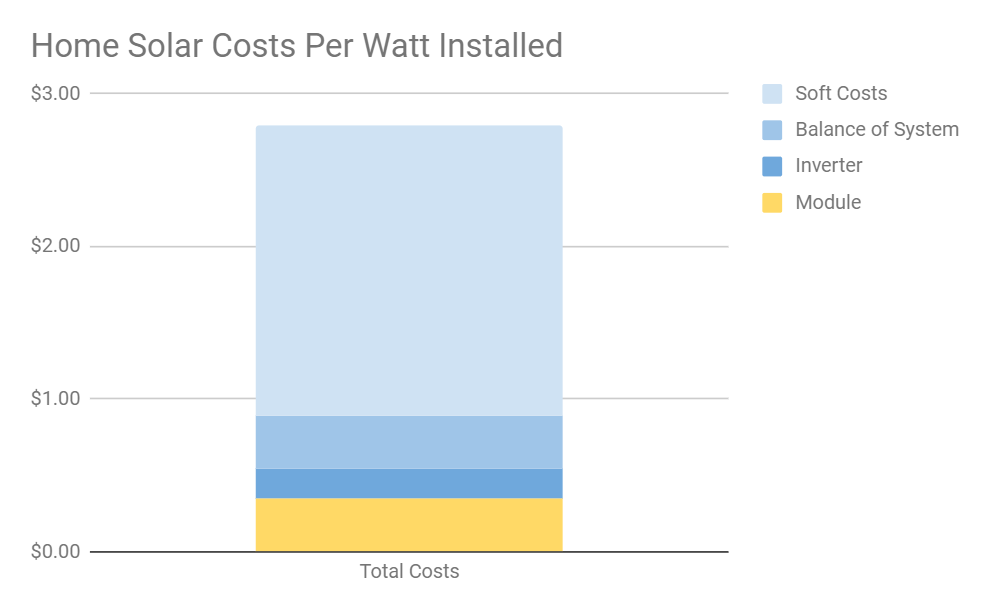In January, President Trump decided to levy new tariffs on imported solar cells and modules that would increase the price of these components by 30%. In siding with foreign-owned manufacturers of solar panels in their trade case, the President’s move could eliminate 23,000 U.S. solar jobs according to SEIA — the exact opposite of an “America First” energy policy, and a decision that was opposed by virtually the entire solar industry and both ends of the political spectrum.
Nonetheless, like so much in today’s news cycle, homeowners need to take the coverage of #TrumpTariffs with a big dose of common sense.
Will this affect solar costs? Yes.
Will it be enough to affect a homeowner’s decision to go solar? Definitely not. Let’s look at the numbers.
How a 30% Tariff Results in Less Than 3% Increase in Solar Costs
To assess the impacts of the #TrumpTariffs, it’s essential for homeowners to understand what goes into the cost of going solar. Just as the price of a new car includes a lot more than just the cost of steel, solar modules are just one component of the final cost of a home solar power system — and it’s a lot smaller portion than one might think.
According to benchmark data from the National Renewable Energy Laboratory, hardware costs accounted for less than a third of total residential solar installation costs on average. “Soft costs” including labor, permitting, customer acquisition, and other non-hardware costs, account for the remaining two thirds.

Data: NREL, U.S. Solar Photovoltaic System Cost Benchmark: Q1 2017
Moreover, those hardware costs include more than just the solar modules subject to the tariff — they also include inverters and balance of system (BOS) components such as racking and electrical wiring. So solar modules account for just 40% of that “less than a third.”
The bottom line? On average, solar modules account for just 13% of the total cost of going solar — so a 30% tariff would increase the final cost of a typical system by just 4%.
That’s not the end of the story, either — those extra costs are included in your calculations for the 30% solar tax credit, which means homeowners actually get 30% of the tariff returned on April 15!
So, when you do all the math, the #TrumpTariffs will add less than 3% to the cost of going solar for a typical homeowner. And the impact will likely be even less in states like Massachusetts, New Jersey, and California, leading solar states where module prices account for a lower share of final costs according to NREL.
You don’t have to take our word for it — analysts from Bloomberg New Energy Finance have similarly predicted a 3% increase in residential solar costs, and EnergySage estimates it could add a $500-$1,000 premium to a typical installation. However you slice it, doing the math really underscores that this is not a big deal for a homeowner’s solar economics.
Financing Lets You Save From Day One
The #TrumpTariffs become even more irrelevant when you consider the fact that more and more homeowners today can go solar with zero money down financing. This allows them to save on their energy bills from day one, with no up-front cost — an incredible value proposition that has been key to the U.S. solar boom over the past five years.
Indeed, by financing a home solar power system, homeowners essentially transform it from a cost into an investment. Not only that, but it’s an investment that pays very reliable returns, since you save money with every kilowatt-hour of energy you generate — and the sun shines every day.
And those savings add up to a lot. For example, the typical Mosaic loan customer saves $30,550 over the life of their installation. While the tariff may eat into that (very) slightly, the cost will be spread out over the 10- to 20-year life of your loan — and, most importantly, you’ll still be saving money each month.
As pretty much every single book on personal finance will tell you, the most important thing to building up your long-term wealth is to start saving as soon as possible. It’s no different with solar: if going solar made economic sense for you before the tariff, chances are it’s still a smart investment today.
Own Your Piece of a Better Future
For some homeowners, choosing solar is purely based on economics.
But for many, it’s also about owning a piece of a better future. Whether you’re more concerned about asthma and lung disease or climate change, or if your priority is being more energy independent and less reliant on your utility, solar empowers you to connect with your values in a powerful way.
Those values — of being good stewards of the planet and good members of our communities — are as important now as they’ve ever been. And if anything, the #TrumpTariffs might just make those values seem even more important and powerful than before.
It certainly feels that way to us. Mosaic was founded because of our own vision of a better future: a 100% clean energy future, where everyone is empowered to prosper from solar. We’re more committed to those values than ever, and we’re confident we can help you share in that prosperity — regardless of the #TrumpTariffs.
